The Growing E-waste: Means to a Livelihood and Resource Management!

The Growing E-waste: Means to a Livelihood and Resource Management! We all know that e-waste is hazardous but we don’t do anything about it. Do you know why? Because we think, let others do it! This is exactly why Namo e-Waste came into being. To begin somewhere, we need everyone’s cooperation. Yours too! Did you know, it was only when China refused to accept 24 varieties of solid waste, that big countries like the US and the UK along with Japan and Australia realized they were in a soup. Until then, China used to take 70 percent of the world’s unused electronic waste. The country realized the harmful impact of e-waste and banned it. Southeast Asia was the next chosen destination to dump the e-waste; soon the countries in the region like Thailand and Vietnam too curbed the e-waste import. Did you observe, how all these countries want others to manage their e-waste and save the planet, as we mentioned earlier; we do not do it because we wait for others to do it. Enough is enough! E-Waste production has surged globally by 21% in just five years, as per a report by the United Nations. What Triggers the Upsurge? It’s no secret that technology has made way in our daily lives in such a way that we cannot look and think beyond it. We live through and sometimes on technology; don’t you spend most of your time with your laptops and phones? We have now moved on to wearable technology; smartwatches, Bluetooth rings, Helmet Sensors and Hololens, etc are used by many. That close, the technology has come to us! With the increasing competition, the prices of electronic gadgets have gone down and so has the quality. This has made the lifespan of electronic gadgets shorter. They are all battery-driven. Some have replaceable batteries while others have the kind that has an expiry date. Although all of us care to buy the latest devices and gadgets to hit the market, none of us care to dispose of the no-longer-used devices carefully, at home. Does that make us smart and hi-tech? You decide! Even businesses upgrade their systems and electronic infrastructure easily instead of getting repaired the older ones. They update their software but allow the discarded hardware to lie defunct and degrade, emitting harmful radiations. The lack of time and manpower compels them to be ignorant. However, it is about time the companies must realize their responsibility and the kind of harm they are causing to the planet and future generations and move towards proper E-Waste management Namo e-Waste Comes into Rescue We understand the constraints that each household and company has and we have come in to fill up the gaps. Electronic devices are designed with a wide mix of materials like silver, gold, copper, palladium, platinum, lithium, cobalt which are valuable, and many other elements like lead, mercury, cadmium, and beryllium that could have harmful effects post the expiry date. Health hazards caused by such elements must be minimized at any cost. Imagine, if we recycle the old electronic devices how much of these non-renewable resources can be saved for future use. Sustainability is the way forward and Namo e-waste, E-Waste recycling company has taken it upon itself to ensure that e-waste present in every corner of the country is sent for scientific disposal for appropriate recycling of waste collected pan India. Namo E-waste has one of the biggest electronic waste recycling plants in India and Do your bit, be part of Namo e-Waste’s ongoing campaign “Together We Care” to collect e-waste from homes, workplaces, communities, companies, etc. E-Waste is a menace, help us regulate it! [/tatsu_text][/tatsu_column][/tatsu_row][/tatsu_section]
Surprising Items You Didn’t Know Could Be Recycled: A Guide to Responsible Disposal
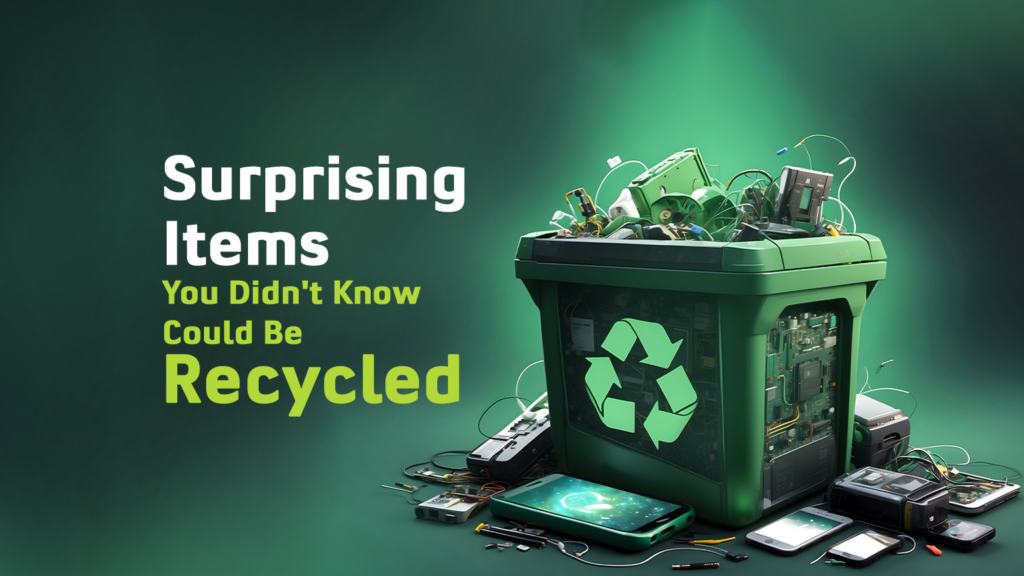
Modern World’ and ‘Recycling’, two terms that are inseparable. Listening to the word ‘Recycling’ what comes to your mind? Is it Plastic? Or is it Paper? What if I tell you there are so many items you don’t know about that can be or rather should be recycled for a greener earth. Discovering Surprising Items for Recycling Welcome to your Guide to Responsible Disposal where we would introduce you to items you wouldn’t believe can be recycled. These simple items you use every day for convenience can be beneficial for our planet if you choose to recycle them instead of dumping them. 1. Recycling Batteries: A Win-Win Solution Yes, the rechargeable batteries that you use, household alkaline batteries, and button cell batteries, all of them are recyclable. They contain harmful materials like lead, cadmium, mercury etc, which if not disposed of properly can be of a great danger to ours as well as our planet’s health. That being said, if you choose to recycle, you not only help to prevent these toxic substances from damaging our soil and water, but also allow valuable materials like zinc, nickel, and lithium to be recovered and reused in new batteries. It’s a win-win situation. 2. Recycling Ink Cartridges: Reducing Plastic Waste The Ink Cartridges that often get piled up in our trash when recycled reduces the demand of new plastic production as well as stops harmful materials from marring our planet. So, Instead of tossing your empty ink cartridges into the trash, let’s consider recycling them. As awareness increases, many office supply stores, electronics retailers, and printer manufacturers offer ink cartridge recycling programs that allow you to return used cartridges for proper disposal and recycling. 3. Recycling Light Bulbs: Safeguarding the Environment Usually, disused Light Bulbs go into our trash cans making the mercury from CFLs dissipate in the environment. But what will recycling do differently? It will allow safe disposal of mercury and also enable the recovery of materials like glass, aluminum, and phosphor powder which can be reused for the future. Let’s consciously make a choice of recycling these light bulbs so that they get a new life and can continue to light our planet. 4. Recycling Electronic Devices: Extracting Valuable Materials Do you remember what you did with the old phone you recently replaced? Chances are, it’s still in your drawer waiting for you to give it a new life. Electronic Devices like phones contain minerals like gold, silver and when you give them for recycling they get extracted helping a new item to come into life. On the other hand, improper disposal of e-waste adds to the already piled up landfills harming our planet inside out. But enough discussing problems, we are here to also provide you an opportunity to be a part of Solution. Namo eWaste: Making Recycling Convenient Namo eWaste offers you a free e-waste pickup from your doorstep giving you accessibility and convenience. And this is how you can contribute to a greener planet just through a few clicks. Conclusion: Pledging for a Greener Future We at Namo eWaste are devoted to doing our part and contributing to a sustainable future for us and as well future generations. With a mission to recycle maximum electronic waste generated we stand firm to minimize adverse impact on our environment and alongside reverse the damage that is already done. Nobody can do this alone, but we all can surely do it together. With comprehensive services offered by us, you can do your part by recycling e-waste around you and promote practices that are eco-friendly. Choose to partner with us and actively participate in a much-needed movement of reducing waste that is threatening for ours and our planet’s life. Join us in our mission to create a world where sustainability is not just an option but a way of life.
The Importance of E-Waste Management Practices
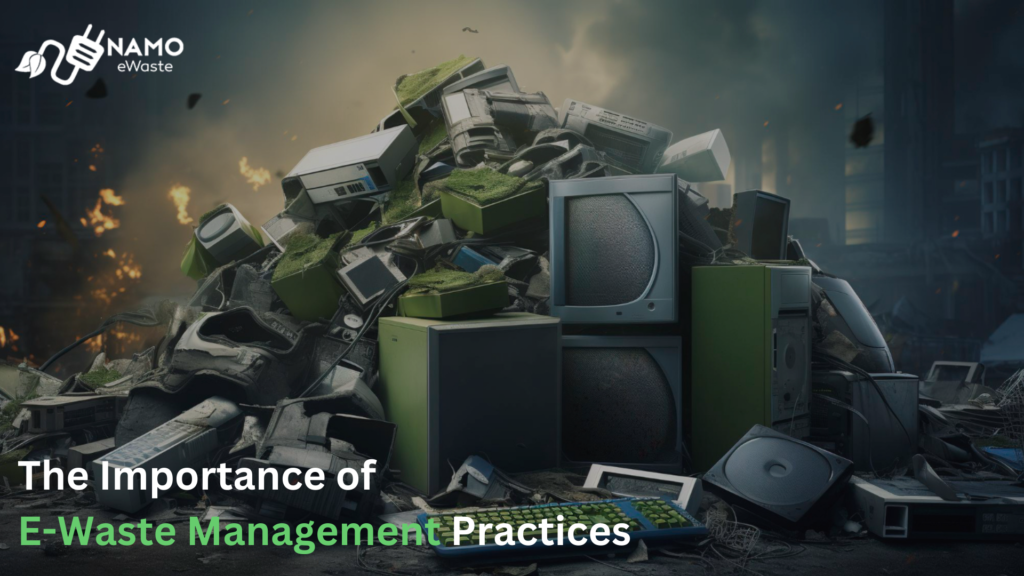
Electronic gadgets are becoming a necessary part of our everyday life in the digital age, acting as instruments for productivity, amusement, and communication. But a worrying tendency has emerged as a result of technology’s quick advancement: an enormous rise in electronic garbage, or “e-waste.” Our constant quest for the newest technology, from computers and cellphones to TVs and refrigerators, has created a serious environmental problem that needs immediate solutions. Challenges in E-Waste Management To reduce the threats that electronic waste poses to the environment and human health, effective e-waste treatment is essential. Still, many obstacles stand in the way of this field’s advancement. The ignorance of customers about the correct recycling and disposal of electronic gadgets is one of the main challenges. Many people throw away their outdated electronics in typical household trash without thinking about the possible environmental damage. The problem is further complicated by a lack of infrastructure for the collection, recycling, and disposal of e-waste. Unsafe procedures used in informal recycling operations in some locations worsen pollution to the environment and put workers’ health at risk. Why is E-Waste Management Important? The significance of best e-waste management practices cannot be overstated. As the consumption of electronics continues to rise, so does the volume of e-waste generated. Proper e-waste management offers several benefits: Energy Conservation: Recycling electrical waste lessens the need to mine natural resources for raw materials. Environmental Protection: Preventing soil and water contamination by keeping e-waste out of landfills contributes to a cleaner, greener world. Minimization of Greenhouse Gas Emissions: Recycling electronic waste reduces greenhouse gas emissions from raw material extraction and production. Resource Recovery: By recycling, valuable metals like gold, silver, and platinum that are present in electronic recyclables can be recovered. E-Waste Management Rules in India E-waste management in India is predominantly informal, with a large portion of collection and recycling handled by the informal sector. However, efforts are underway to streamline e-waste management practices through legislative measures. In November 2022, the Ministry of Environment and Forests notified the E-Waste (Management) Rules, 2022, aimed at digitizing the e-waste management process and enhancing transparency. Key provisions of the rules include: Extended Producer Responsibility (EPR): Manufacturers are responsible for managing the disposal and recycling of electronic products once they reach the end of their lifecycle. Collection Targets: Companies must collect a certain percentage of the electronic products they sell each year for recycling or proper disposal. E-Waste Exchange: An online platform facilitates the exchange, return, and recycling of e-waste among producers, consumers, and recyclers. Deposit Scheme: A deposit refund system encourages consumers to return electronic products for recycling by offering refunds upon return. Guidelines for Recyclers: Safe and efficient processing of e-waste is ensured through guidelines for recyclers. Penalties for Violations: Non-compliance with the rules may result in fines or other legal actions. Namo eWaste is dedicated to solving the problem of e-waste management by offering complete solutions catered to the requirements of both people and companies. Namo eWaste guarantees responsible handling of electronic trash with minimal environmental impact, thanks to its modern facilities and committed staff. By working together with Namo eWaste, you can efficiently recycle your e-waste and contribute to a sustainable future. To sum up, adopting the best e-waste management techniques is crucial to attaining sustainable living and safeguarding the environment for coming generations. By raising awareness, working together, and taking responsible action, we can manage e-waste and make the world a cleaner, greener place. Today, let’s begin our journey toward a sustainable lifestyle.
Closing the Loop: The Environmental Impact of E-Waste Recycling
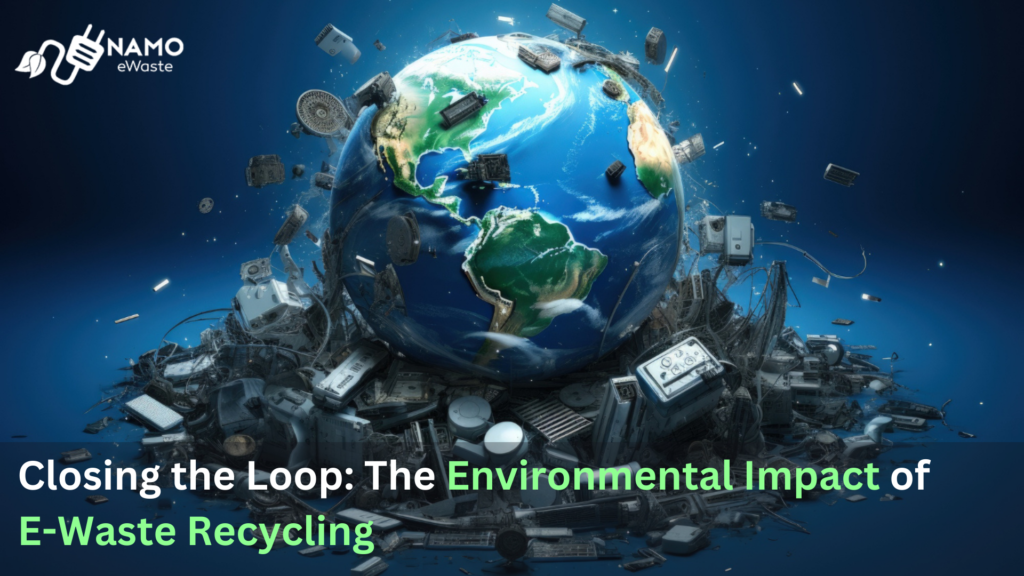
In our digital age, the rapid evolution of technology has led to a surge in electronic consumption, resulting in a corresponding increase in electronic waste, or e-waste. From outdated smartphones to obsolete laptops, electronic gadgets have a finite lifespan, contributing to the mounting electronic garbage crisis. As a result, the hazards of electronic waste have become a pressing concern globally, necessitating effective e-waste disposal and recycling solutions. The term “e-waste,” or electronic garbage, refers to a wide range of abandoned electronic devices, such as computers, televisions, cellphones, and home appliances. Because these electronic cast-offs contain dangerous substances including lead, mercury, cadmium, and flame retardants, they pose serious environmental dangers. Inadequate management and elimination of electronic waste can result in contaminated land and water, air pollution, and harmful health consequences for both people and animals. Effect on Soil The effects of electronic waste on the environment are extensive and diverse. When electronic trash is illegally disposed of, heavy metals and other chemicals seep into the soil, undermining its fertility and damaging crops. This process is known as soil contamination. When food cultivated in impacted areas becomes contaminated, both humans and animals may be at risk for health problems. Effect on Air Another negative effect of improper handling of e-waste is air pollution, especially in areas where shredding or burning of electronic components is part of unofficial recycling procedures. Communities located distant from recycling operations may be impacted by the long-lasting, harmful gases and dust particles emitted during these procedures, which can cause respiratory conditions. Effect on Water The most subtle effect of e-waste is probably water contamination, as dangerous materials leak into surface and groundwater sources, threatening aquatic ecosystems and posing a health risk to humans. Fish and other aquatic species can accumulate heavy metals like lead and mercury, which can be dangerous to wildlife and people who eat contaminated seafood. Effect on Humans Exposure to e-waste chemicals has been shown to have detrimental impacts on human health, ranging from neurological diseases and respiratory problems to cancer and reproductive concerns. Pregnant women and children are among the vulnerable groups most at risk. In India, the proliferation of electronic devices has amplified the challenge of managing electronic waste. With the country’s rapid economic growth and increasing technological adoption, the volume of electronic waste generated annually has soared, exacerbating environmental concerns. The lack of adequate infrastructure for e-waste disposal and recycling further compounds the issue, leaving many communities vulnerable to the adverse effects of electronic garbage. In this regard, electronic recycling companies play a pivotal role in closing the loop on e-waste. These specialized firms utilize advanced technologies and processes to dismantle, recycle, and repurpose electronic waste, extracting valuable materials and minimizing waste sent to landfills. By partnering with electronic recycling companies, individuals and businesses can ensure that their electronic garbage is disposed of responsibly and ethically, contributing to a more sustainable future. One such electronic recycling company making strides in the field is NAMO eWaste. Committed to environmental stewardship and sustainability, NAMO eWaste offers comprehensive e-waste recycling solutions tailored to the needs of businesses and individuals. With state-of-the-art recycling facilities and a dedicated team of experts, NAMO eWaste ensures that electronic waste is managed efficiently and in accordance with environmental regulations. In conclusion, the environmental impact of e-waste recycling cannot be overstated. By addressing the hazards of electronic waste through responsible disposal and recycling practices, we can safeguard our planet and preserve its natural resources for future generations. With the support of electronic recycling companies like NAMO eWaste, we can turn the tide on the e-waste crisis and create a more sustainable world for all.
Revolutionizing Sustainability: The Role of Namo eWaste in Recycling E-Waste in India
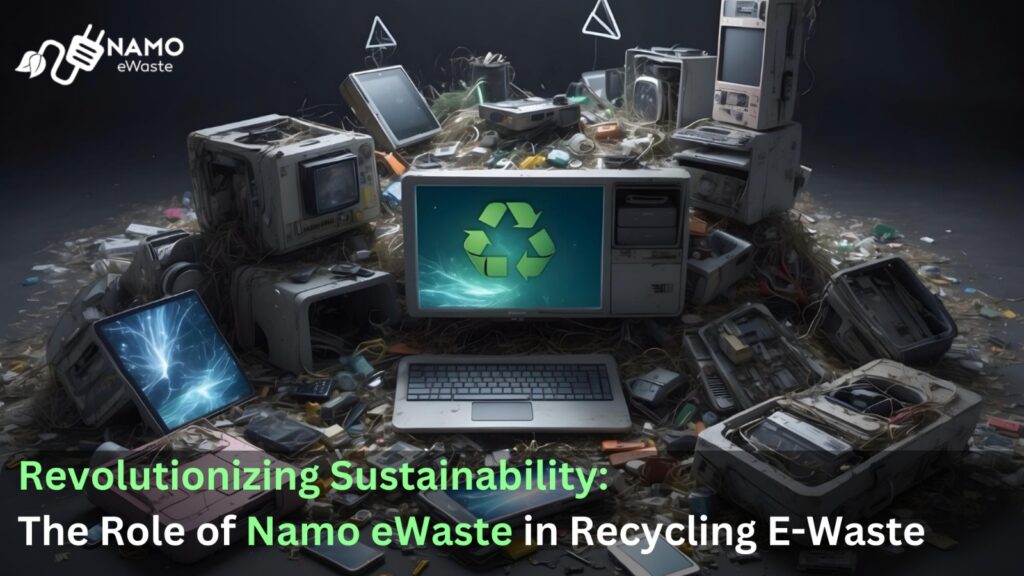
India is embracing the digital revolution. But the sudden digitization has led to a surge in electronic waste (e-waste), posing a significant environmental and health challenge. With an estimated 2 million tonnes of e-waste generated annually, India faces a shortage of responsible e-waste management companies. At Namo eWaste, we take the front seat to revolutionize the e-waste management system in India. EPR Services: Ensuring Responsible E-Waste Management Recycling e-waste in India is not a challenging task,it is the lack of awareness that is holding companies& manufacturing units to take sensible actions. To help you understand this, let’s first understand what EPR is. Short for Extended Producer Responsibility, EPR is a game-changer in the waste management sector, holding manufacturers, producers, importers, and bulk consumers responsible for their products’ end-of-life management. According to the e-Waste Management Rule 2016 and Amendment Rule 2018, manufacturers, producers, importers, and bulk consumers of electrical and electronic equipment have yearly targets to fulfill their EPR obligations. Namo eWastesteps in as your trusted EPR partner, assisting you with: EPR Registration: We simplify the complex registration process with the Central Pollution Control Board (CPCB) through our expert guidance. Meeting Recycling Targets: We offer comprehensive recycling services ensuring you achieve your mandated targets efficiently and sustainably. Compliance Support: Stay compliant with all EPR regulations and avoid potential penalties with our experienced team by your side. Awareness Programs: Enhance stakeholder awareness about responsible e-waste disposal through our collaborative programs. ITAD: Secure and Sustainable Asset Disposition Beyond e-waste recycling, Namo eWaste goes further by being the largest IT Asset Disposition (ITAD) provider in India. We understand the critical need for secure and environmentally responsible management of your organization’s IT assets, whether data-bearing or not. Our ITAD services guarantee: 100% Data Destruction: Protect sensitive information with our secure and certified data destruction processes. Minimized Environmental Impact: We prioritize sustainable practices, maximizing resource recovery, and minimizing environmental footprint. Maximized Asset Recovery Value: Get the most value out of your decommissioned assets through responsible remarketing or recycling. Embracing Sustainable Excellence: As a responsible ITAD provider, Namo eWaste adheres to the highest standards, meeting critical requirements in: Data Security Information Privacy Environmental Protection Traceability Compliance Redeployment Remarketing Recycling Circular Economy By choosing Namo eWaste, you partner with a leader in sustainable e-waste management and responsible ITAD services. Let us help you fulfill your EPR obligations, protect your data, and contribute to a cleaner, greener future for India. Together, let’s revolutionize sustainability!
Convenience at Your Doorstep: The Advantages of E-Waste Collection from Home
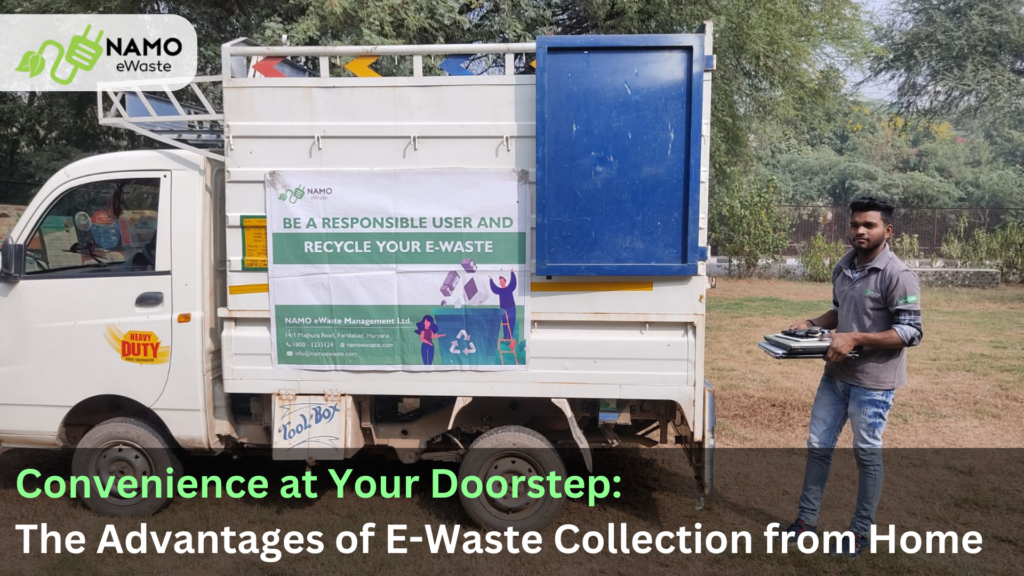
When a new phone hits the market, most of us are willing to buy it. And not just phones, we love to own tablets, PCs, laptops, and other e-devices that are launched with new & updated features. This consumer behaviour has no doubt benefited these manufacturing companies; but then, who is calculating the impact our environment is facing? Well, we did the research, and it says “Approximately 75% of electronic waste (e-waste) in India is generated by government, public sector companies, and private sector companies, while individual households contribute only around 16%.” Source: Statistica This staggering statistic underscores the urgent need for effective e-waste management practices across the country. We believe that proper recycling of e-waste in India is not just a choice but a necessity for India’s sustainable future. Namo’s Vision: Namo is dedicated to leveraging the expertise, resources, and experience to foster a sustainable future for our planet Earth. They have recognized that e-waste management is one of the most critical challenges India is facing at the moment. With access to 70% of India’s e-waste, they have strategically positioned themselves to make a meaningful impact in this area. Their commitment extends beyond mere awareness and is actively working towards tangible solutions to address the growing e-waste crisis. Our Procedure: Collection and Transportation: Our comprehensive process begins with the collection of e-waste from your doorstep. Our facilitators ensure the safe transportation of e-waste to our R2-certified facilities. Our fleet of vehicles, in collaboration with our channel partners, facilitates efficient reverse logistics, guaranteeing the secure delivery of both hazardous and non-hazardous e-waste. Asset Refurbishment: Repairable items undergo asset refurbishment to bring them back to life. Damaged components are replaced with high-quality, cost-effective spares to enhance product longevity. Thorough ‘Quality Checks’ are conducted to ensure the efficiency, satisfaction, and safety of refurbished products. Standard and extended warranties are offered for these refurbished products. Recycling: Salvageable parts from non-repairable items are extracted for reuse in repairing other devices. The remaining portions are meticulously disassembled and categorized for environmentally friendly disposal. Conclusion: With the rapid pace of technological advancement, electronic devices have become an integral part of our daily lives. However, the disposal of these devices poses significant environmental and health risks if not managed properly. In the pursuit of a sustainable future, Namo is committed to leading the charge of e-waste management in India. By implementing innovative solutions and adhering to the highest standards of environmental responsibility, they are striving to realize our vision of a cleaner, greener tomorrow. Namo is dedicated to managing e-waste by enabling the service of e-waste collection from home. They are trying to put their best foot forward to protect our environment and communities. Someone has rightly said that charity begins from home- so, let’s work together toward a brighter and more sustainable future.
Environmental Advantages of Electronics Recycling
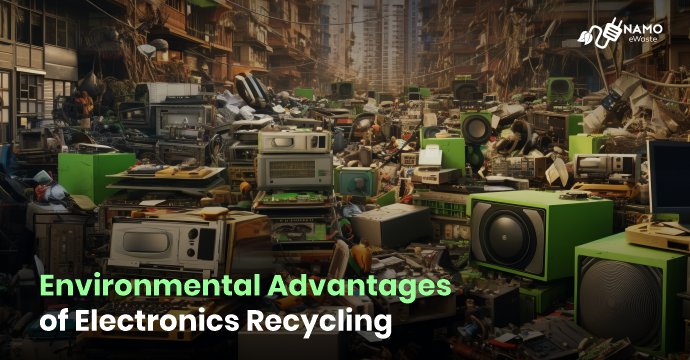
We all love our gadgets. From smartphones and laptops to tablets and gaming consoles, they connect us, entertain us, and fuel our modern lives. But what happens when these beloved devices reach the end of their lifespan? Unfortunately, many end up in landfills, creating a hidden danger we rarely consider: e-waste. E-waste, short for electronic waste, is the fastest-growing waste stream globally. This discarded tech harbours a dark secret: a cocktail of toxic materials like lead, mercury, and cadmium. When e-waste ends up in landfills, these toxins can leach into the soil and water, poisoning ecosystems and harming human health. But there’s a hero in this story: e-waste recycling By responsibly recycling e-waste, we can unlock a treasure trove of environmental benefits, and we’re here to guide you on this eco-friendly journey. The Power of E-waste Recycling Recycling e-waste isn’t just about decluttering your drawers; it’s about making a conscious choice for the planet. Here’s how it works: 1. Reduces reliance on virgin materials Mining for new metals and minerals used in electronics has a significant environmental impact. Recycling e-waste recovers valuable resources like gold, silver, and copper, reducing the need for further mining and its associated pollution. 2. Combats climate change Manufacturing new electronics requires immense energy. By recycling e-waste, we significantly reduce the energy needed for production, minimising greenhouse gas emissions and contributing to the fight against climate change. 3. Prevents air and water pollution Improperly disposed of e-waste can release harmful toxins into the air and water when they burn or decompose. E-waste recycling plants like Namo eWaste handle e-waste responsibly, preventing these dangerous pollutants from harming our environment and ourselves. 4. Conserves precious landfill space Landfills are overflowing and e-waste takes up valuable space that could be used for other purposes. Recycling e-waste diverts it from landfills, extending its lifespan and preserving precious land for future generations. 5. Creates green jobs The e-waste recycling industry generates employment opportunities in various sectors, from collection and processing to refurbishment and remanufacturing. By choosing e-waste recycling, you’re not just helping the environment; you’re supporting a sustainable economy. 6. Builds a Circular Economy E-waste recycling is more than just a waste management solution; it’s a cornerstone of a circular economy. By keeping resources in use and minimising waste, we create a more sustainable future for ourselves and generations to come. we’re committed to being a part of this positive change, and we invite you to join us on this journey. Make a difference Namo eWaste is committed to making e-waste recycling accessible and convenient for everyone. We offer a variety of services, including: Convenient e-waste collection from home or office No need to leave your comfort zone. We’ll pick up your e-waste at your doorstep, ensuring a hassle-free experience. Responsible and transparent processing We adhere to the highest environmental standards, ensuring your e-waste is recycled responsibly and ethically. Data security We understand the importance of protecting your data. We offer secure data destruction services to ensure your personal information is completely erased before recycling. Final Takeaways Recycling e-waste is not just a trend; it’s a necessity for a sustainable future. By choosing Namo eWaste as your partner, you’ll be making a conscious choice to protect our planet and its resources. Let’s join hands and turn our e-waste into a force for good. Take action today! Visit our website to learn more about our e-waste recycling services and schedule a convenient pickup. Remember, every recycled device is a step towards a cleaner, greener future. Together, we can make a difference!
Leveraging EPR for Brand Advantages
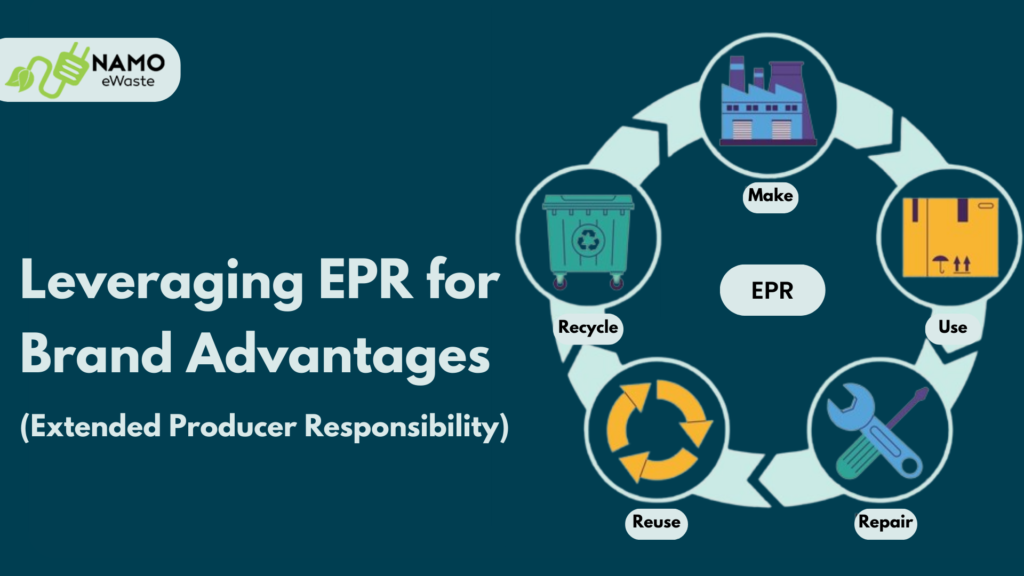
In today’s environmentally conscious world, consumers are increasingly looking for brands that align with their values. One way for businesses to demonstrate their commitment to sustainability is by taking responsibility for their products’ end-of-life management through Extended Producer Responsibility (EPR). What is EPR and Why is it Important? EPR is a policy that makes manufacturers financially and physically responsible for the collection and recycling of their products at the end of their useful life. This includes electronic waste, or e-waste, which is one of the fastest-growing waste streams in India. Why Should Your Brand Care About EPR? There are many benefits to complying with EPR, both for the environment and your brand. Here are a few. Adopting EPR-supportive actions: Boosts your brand image Consumers are more likely to trust and support brands that are seen as environmentally responsible. By complying with EPR, you can show your commitment to sustainability and differentiate yourself from your competitors. Reduces costs By collecting and recycling your products, you can save money on waste disposal costs. You can also sell valuable materials recovered from e-waste, such as metals. Improves compliance EPR is becoming increasingly mandatory in India and around the world. By complying early, you can avoid potential fines and penalties. Contributes to a circular economy As a brand, when you opt for recycling e-waste, you can help create a circular economy where resources are kept in use for as long as possible. This reduces the need for virgin materials and helps conserve the environment. How Can Namo eWaste Help You Comply with EPR? Namo eWaste is a leading e-waste management company in India. We offer a comprehensive range of services to help businesses comply with EPR regulations, including: E-waste collection: We provide convenient and secure e-waste collection services for businesses of all sizes. We can collect e-waste from your doorstep or set up collection points at your facilities. E-waste recycling: We have state-of-the-art e-waste recycling plants where we process e-waste responsibly and sustainably. We extract valuable materials from e-waste, such as metals and plastics, which are then recycled into new products. Compliance support: We can help you understand and comply with EPR regulations. We can also provide you with reports and documentation to demonstrate your compliance. By partnering with Namo eWaste, you can leverage EPR to gain a competitive advantage, improve your brand image, and contribute to a more sustainable future. Here are Some Ways We Can Help You: Reduce your e-waste footprint: We can help you track and reduce the amount of e-waste you generate. Increase your recycling rates: We can help you recycle more of your e-waste and divert it from landfills. Recover valuable materials: We can help you extract valuable materials from your e-waste, which can be used to make new products. Comply with regulations: We can help you understand and comply with government EPR regulations. Namo eWaste is committed to helping businesses achieve their sustainability goals. In addition to the benefits mentioned above, complying with EPR can also help your brand: Build stronger relationships with your customers – Consumers are increasingly loyal to brands that share their values. By complying with EPR, you can show your customers that you care about the environment and that you are committed to doing your part. Attract and retain top talent – Employees are also looking for companies that are committed to sustainability. By complying with EPR, you can make your company a more attractive place to work. The Way Forward EPR indicates a new era of environmental accountability across the e-waste ecosystem. It pushes brands to not just design better products but also take ownership of their end-of-life impact. Brands that lead this culture change through partnerships with compliant service providers will reap outsized rewards in both market success and public esteem as sustainability pioneers. Become a sustainability torchbearer while optimizing business value – partner with Namo eWaste for your EPR needs. Namo eWaste is a one-stop shop for all your e-waste management needs. We have the expertise and experience to help you comply with EPR regulations and achieve your sustainability goals. Contact us today to learn more about how we can help you
Inefficient Segregation: The Main Obstacle To Effective eWaste Recycling

eWaste or electronic waste refers to discarded electrical or electronic devices. With the rise in consumption and shorter lifespan of gadgets, eWaste generation has increased rapidly. With components like lead, mercury, cadmium etc., eWaste can be highly toxic and have a devastating impact on health and the environment if not disposed of properly. Efficient eWaste recycling involves the extraction of all reusable components and the safe disposal of hazardous materials. However, one of the main obstacles to effective eWaste recycling is inefficient segregation. What is Inefficient Segregation of eWaste? Segregation refers to the systematic separation of various elements in eWaste for easier processing and enhanced value extraction. When segregation is not done properly, different components get mixed making recycling complicated. In India, a large chunk of eWaste ends up in informal sectors. Here, unscientific methods are used for extraction which leads to hazardous byproduct generation. Components like batteries and circuits get dismantled together causing contamination. Such mixing poses the following risks: Safety Hazards: Incompatible materials when stored together can result in chemical reactions or explosions. For example, discarded lithium batteries can react with other junk and cause fire breakouts. Difficulty in Processing: When various elements like plastic, glass, and metals get mixed, separating them requires more complex techniques, manpower and infrastructure. Many companies avoid such eWaste batches. Loss of Recoverable Elements: Mixing makes extraction of reusable metals like gold, silver etc. unviable. It also leads to damage and corrosion of such recoverable elements. Environmental Contamination: Informal processing of complex unsorted eWaste gives rise to byproducts like dioxins which contaminate air, water and soil. Effective Segregation: The First Step for eWaste Recycling Companies With the rising relevance and economic potential of the eWaste recycling sector, systematic segregation is the need of the hour. Namo eWaste ensures complete segregation by: Separating devices into categories: We segregate devices into categories like large appliances, small appliances, and IT accessories and communicate classification protocols across collection centres. Dismantling with precision: Our trained technicians carefully dismantle devices and separate components like circuits, batteries, metals etc. Appropriate storage: Different elements are stored distinctly in labelled containers to avoid contamination. Such streamlined segregation facilitates smooth functioning in our subsequent recycling process. Namo eWaste’s Step-by-Step eWaste Recycling Process Our state-of-the-art facilities follow a streamlined recycling process: Collection: We collect eWaste from businesses across India that replace electronic devices regularly. Sorting & Segregation: Items are categorised and dismantled into components. Processing: Components are sent for processing via appropriate techniques. Disposal: Hazardous residuals are disposed of scientifically to prevent environmental damage. Resource Extraction: Reusable metals, plastic granules and glass cullet are extracted. With efficient separation through manual dismantling and mechanical shredding, we can extract all elements in eWaste without external contamination. With Namo eWaste, you can: Easily schedule doorstep pick-up: No more lugging around your old gadgets. Namo eWaste comes to you! Rest assured of responsible recycling: Their state-of-the-art facilities and stringent protocols guarantee environmentally sound processing of your eWaste. Contribute to a greener future: Every gadget you responsibly recycle with Namo eWaste is a step towards a cleaner planet and a more sustainable future. Integrated Approach for 360° eWaste Recycling in India With the increasing penetration of electrical and electronic devices across socio-economic segments in India, managing eWaste volumes has become pivotal. Namo eWaste adopts a holistic approach across the eWaste recycling value chain spanning collection, transportation, dismantling, segregation, material recovery, treatment and disposal. Our integrated services conform to the highest environmental, health and safety standards. We also prioritise ethical practices, data security, transparency and compliance with Central and State government rules on eWaste handling as a registered recycler. By responsibly partnering at each step, we enable safe and complete recycling in India. Committed to Keeping India’s Environment Clean We employ advanced automated dismantling lines, sorting systems and scientific disposal mechanisms for the eco-friendly management of eWaste. As India’s leading eWaste recycler, we are committed to efficient recycling processes which minimise environmental impact. Our systematic segregation practices enable maximum extraction of resources and prevent contamination during recycling. Partner with us for safe and responsible eWaste recycling!
EPR Compliance for Medical Devices: Rules Defined in 2022

The implementation of EPR, which enables manufacturers to assume full responsibility for the collection of end-of-life equipment and their safe disposal, is used to manage e-waste in India. Manufacturers and distributors would have to collect e-Waste by giving customers a designated place to dispose of it. The government has made recycling and dismantler registration mandatory in order to guarantee compliance. The EPR e-Waste Management Regulation 2022 mandates that all producers of EEE, including manufacturers, recyclers, refurbishers, and makers, register on the platform. Electronic waste (e-waste) needs to be recycled, disposed of appropriately, or repaired. As per recent guidelines, medical device waste (MDW) category has been added for the very first time by CPCB in the list of eWaste. List of medical devices for EPR registration according to CPCB from code MDW1 till MDW10, medical devices (with the exception of all implanted and infected products), radiotherapy equipment, cardiology equipment, dialysis equipment, pulmonary ventilators, nuclear medicine equipment, laboratory equipment’s , analyzers, PET, MRI, CT, ultrasound equipment, other electric devices, tools, and kits that are used for preventing, screening, detecting, monitoring, evaluating, reviewing, examining, investigating, probing, or treating illnesses, diseases, disorders, afflictions, infections, injuries, trauma, abuse, or disabilities, such as mobile phones, tablets, or any other device with the capability of sex selection and their accessories. For producers, importers, manufacturers, and brand owners, an EPR authorization is required. The OECD is working to broaden the scope of extended producer responsibility (EPR) to cover more goods, product categories, and waste streams, including electronics and electrical appliances. Obligations that medical device manufacturers have when releasing their products onto the market for retail sales. Application of the EPR guidelines that the government agencies have issued. Gathering and transporting manufactured, produced, and imported e-waste to approved collection sites, recyclers, or dismantlers.The development of awareness campaigns about disposing of discarded devices and the methods used to treat them. Describe and make available the facilities for the collection, processing, and recycling of the manufactured goods. Supplying comprehensive instructions on how to handle hazardous materials, including how to safely disassemble various electronics and devices. Labeling of indelible forms.The manufacturers are required to produce a record of the waste generated by the gadget. With the surge in demand for medical Devices since COVID 19, there is a demand for new regulations of the different categories of waste medical devices for the medical device industry in India. Through the segregation of the waste medical devices at the collection centers, and the involvement of these bodies in the management of different categories of waste. In order to ensure the safe management of waste medical devices, it is essential that it be done in an organized manner with enough resources and sustainable recycling technologies. Namo e-Waste an electronic recycling company is a sustainable and cost-effective company for disposing electronic waste including MDW category across the country. We provide comprehensive recycling services for getting rid of eWaste efficiently and in environment friendly way and that makes our facility one of the most sustainable in the country with zero waste discharge technology. Our team is committed to providing you with reliable, affordable and sustainable solutions for managing your EEE waste.

